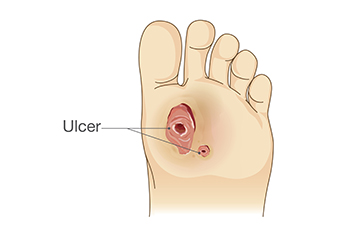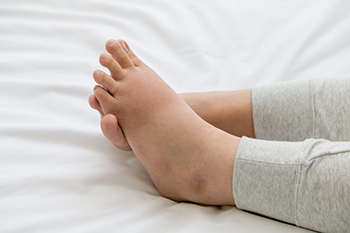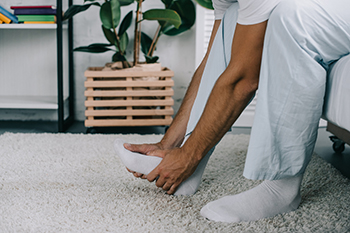Participating in sports is great for maintaining your health and fitness, but can sometimes result in injuries to your feet or ankles. Common sports-related foot and ankle injuries include Achilles tendonitis, ankle sprains, stress fractures, turf toe, and plantar fasciitis.
Achilles tendonitis is a common injury in which the Achilles tendon located at the back of your ankle becomes inflamed due to overuse or biomechanical issues with the feet. Symptoms of Achilles tendonitis include pain in the lower calf, swelling, stiffness, redness, warmth, and reduced strength and range of motion.
Ankle sprains occur when the ligaments in the ankle are overstretched or torn. Depending on the severity of the injury, you may experience symptoms such as localized pain, swelling, and bruising at the site of the sprain, a limited ability to move the affected ankle, and difficulty walking.
Stress fractures are fine cracks that occur in the bones when they can’t bear the load placed on them. These fractures often occur in the foot bones and get worse over time if they are not promptly diagnosed and treated. Symptoms of stress fractures in the feet include tenderness, deep and dull or sharp and localized pain, weakness, swelling, and bruising.
Turf toe is a sprain of the largest joint in the big toe. It can cause symptoms such as pain, swelling, or tenderness that vary in intensity depending on the severity of the injury.
Plantar fasciitis is an inflammation of the ligament that runs along the bottom of the foot. This condition usually causes stabbing heel pains, arch pain, and pain when taking your first steps after a long period of rest.
If you have injured your feet or ankles while playing sports, it is recommended that you see a chiropodist who can diagnose and treat your condition and get you back on your feet.

Ice skating can be fun, but skaters are susceptible to ankle pain and injuries while participating in this sport. Ice skating involves sudden starts and stops that can place strain on the feet, arches, and ankles. The design of the lower leg makes the ankles particularly vulnerable to injury. Two major muscles, the peroneal and tibialis anterior, take the most stress from ice skating, and these muscles are most apt to sustain inflammation or injury. The peroneal muscle contracts to pick up the feet and can cause pain on the outside of the ankle. The tibialis anterior muscle runs down the outside of the shin. Long stretches of skating can cause this muscle to shorten and can exert pressure on the tendon leading to foot pain at the front of the ankle, in the arches, and along the outside of the foot. Using properly fitted skates with optimum flexibility, orthotics, and padding in the areas that put pressure on the ankles can help alleviate the pain and reduce the risk of injury. Stretching and strengthening exercises might help as well. If you are an ice skater and experience ankle or foot pain, consult with a chiropodist who can diagnose the problem and offer treatment options.
Injuries to the foot and ankle are very common among athletes. If you have experienced an injury, please consult with one of the specialists from Thornhill Foot Clinic. Our chiropodists will assess your condition and provide you with quality foot and ankle treatment.
Common Injuries Among Athletes:
Achilles tendon injuries
Ankle strains or sprains
Plantar fasciitis
Fractures
Turf toe
Joint dislocations
Sever’s disease
Morton’s neuroma
Symptoms
Symptoms will depend on the cause and severity of the injury. Common symptoms for a foot or ankle injury include pain, swelling, tenderness, bruising, a reduced range of motion, and difficulty bearing weight or walking on the affected foot or ankle.
Diagnosis
Sports injuries are typically diagnosed after carefully examining the affected foot or ankle. This includes moving the injured area to test its range of motion. Medical history will need to be provided, as well as detailed information about how the injury occurred. Imaging studies, such as X-rays or MRIs, may be used to confirm or rule out certain diagnoses.
Treatment
Just like symptoms, treatment will depend on the type of injury and its severity. Initial treatment for many sports injuries is aimed at controlling inflammation and promoting the healing response. The acronym R.I.C.E is a helpful guide to implement for most acute injuries. This method involves resting, icing, compressing, and elevating the affected foot or ankle. In addition, anti-inflammatory medications may be administered and orthotic devices may be prescribed. For more severe injuries, surgery may be required. Lastly, rehabilitation or physical therapy may be needed to gain full functionality in the afflicted area.
If you have any questions, please feel free to contact our office located in . We offer the newest diagnostic and treatment technologies for all your foot care needs.
Though diabetes begins with the pancreas not producing enough insulin, thus raising your blood sugar levels, it is a systemic condition that can affect every part of your body. The feet are no exception, and a variety of lower limb problems are very common among people with diabetes.
One of the primary foot-related concerns for patients with diabetes is diabetic foot ulcers (DFUs). These are poorly healing open wounds on the feet that are at high risk of becoming infected due to a weakened immune system, another common complication of diabetes. Nerve damage in the feet caused by high blood sugar levels interferes with pain signaling between the peripheral nerves in the feet and the central nervous system (the brain and spinal cord). When this signaling is disrupted, it can be difficult to detect foot injuries, such as cuts and scrapes, when they occur. These injuries are then left unnoticed and untreated until they have significantly worsened. Poor circulation, another complication of diabetes, means that not enough nutrients reach the feet. Without them, the wounds on the feet heal slowly and poorly, or not at all. These wounds can then become infected, leading to tissue death.
The best way to prevent DFUs and their consequences is to carefully monitor the health of your feet through daily foot inspections. Using a mirror to help you see your feet fully, look for any cuts, scrapes, sores, bruising, swelling, discoloration, rashes, hair loss, deformities, or nail changes. Take note of any foul odors, pain, warmth, and strange sensations such as numbness, tingling, burning, or pins and needles. If you notice a problem, seek the care of a chiropodist as soon as possible. Early treatment is key to avoiding potential complications.
DFUs are not the only foot problem diabetics are more likely to encounter. Diabetes can also increase your risk of corns and calluses, cracked skin, bunions, hammertoes, Charcot foot, nail disorders, and various infections. If you have diabetes, it is strongly suggested that you are under the care of a doctor who can help you monitor your foot health, treat any existing conditions, and prevent future ones.

Having diabetes brings a multitude of foot problems with it. Neuropathy is a common disorder for diabetic patients to have. This is defined as nerve damage that can happen from elevated insulin levels, and it causes the inability to feel existing cuts on the feet. It is beneficial for the feet to be checked each day to look for abnormalities. This can be accomplished by using a mirror, or by having a caregiver or family member check them. Additionally, proper foot care involves washing and drying the feet daily, and it is beneficial to refrain from walking barefoot. It is suggested to have the toenails trimmed weekly, and this is often done by a chiropodist. The ideal shoes that are worn will fit well and be comfortable, and wearing socks without a seam may help to prevent skin breaks and rubbing. If you have questions about how to perform proper diabetic foot care, it is advised that you are under the care of a chiropodist who can help manage this condition.
Diabetes can cause serious problems in the lower limbs if proper preventive measures are not taken and diabetic wound care is not performed. If you would like to learn more about caring for diabetic feet, please consult with one of the specialists from Thornhill Foot Clinic. Our chiropodists can help you maintain the health of your lower limbs and your mobility.
Diabetes can lead to a host of foot and ankle complications, including:
Poor circulation
Peripheral neuropathy
Diabetic foot wounds and ulcers
Infection
Corns and calluses
Dry, cracked skin
Nail disorders
Hammertoes
Bunions
Charcot foot
If you have diabetes, you must be vigilant of any changes in your foot health. This is best done through daily foot inspections. Using a mirror to help you if necessary, look for any:
Cuts, scrapes, sores, or wounds
Bruising or discoloration
Swelling
Rash
Foul odor
Nail changes
Hair loss
Warmth and inflammation
Deformities
Lower limb pain
Strange sensations (numbness, tingling, burning, pins, and needles)
If you detect anything unusual, seek the care of a chiropodist as soon as possible. If you have any questions, please feel free to contact our office located in . We offer the newest diagnostic and treatment technologies for all your foot care needs.
The ankle is the region that joins the foot and leg. It consists of three joints that allow the foot to move. Pain in the ankle is typically the result of injury or inflammation from a wide variety of conditions, such as strains, sprains, fractures, or arthritis. Symptoms that often co-occur with ankle pain include swelling, bruising, numbness, tingling, stiffness, joint instability, and difficulty walking.
The underlying cause of your ankle pain can be diagnosed by a chiropodist. A diagnostic visit to this specialist typically involves providing a medical history, describing your ankle pain, and undergoing a physical examination. In some cases, the chiropodist may order imaging studies, such as an X-ray or ultrasound, to rule out or confirm a diagnosis.
The right treatment for your ankle pain will depend on the underlying cause of the pain. In many cases, your chiropodist may recommend that you follow the R.I.C.E. acronym: resting, icing, compressing, and elevating the affected ankle. Taking these actions generally decreases swelling and inflammation, reduces pain, and promotes healing. Taking over-the-counter, nonsteroidal anti-inflammatory drugs may also help with pain management. The chiropodist may also prescribe custom orthotics, immobilize the affected ankle, or recommend activity and footwear modifications. In cases of more severe injuries, surgical treatment may be necessary.
If you are experiencing ankle pain, it is recommended that you seek the care of a chiropodist.

The three main causes of swollen ankles, known as edema, are said to be pregnancy, heart disease, and overuse. These can result due to the body holding on to too much fluid, which eventually settles in the ankles and feet. Symptoms associated with edema include pain, shoes that feel too tight, and trouble walking. In addition, one might experience shortness of breath and an inability to exercise. Edema generally coincides with an underlying condition like fluid imbalance, injury, or inflammation. Other causes include walking or exercising too frequently, or on the contrary, sitting in one place for too long. Pregnancy, autoimmune problems, and blood clots may also cause edema. Medical conditions like poor circulation, heart disease, and kidney disease can contribute to swelling as well. If the swelling in your ankles has become chronic, it is suggested that you visit a chiropodist who can perform tests to identify the cause and suggest appropriate treatment plans.
Ankle pain is a common symptom of many lower limb problems. If you are experiencing ankle pain, please consult with one of the specialists from Thornhill Foot Clinic. Our chiropodists will assess your condition and provide you with quality foot and ankle treatment.
The ankle is composed of a number of muscles, bones, tendons, and ligaments. There are many conditions which may cause ankle pain.
Causes
Ankle strains or sprains
Achilles tendon injuries
Fractures
Bursitis
Arthritis
Gout
Tarsal tunnel syndrome
Symptoms
If you have ankle pain, you may also experience a variety of other symptoms depending on the underlying cause of the pain. Some of these symptoms may include ankle swelling, bruising, redness, numbness or tingling, instability, and difficulty walking.
Diagnosis
The underlying cause of ankle pain can be diagnosed by a chiropodist. Diagnoses are typically made based on your medical history, a physical examination of the affected ankle, and imaging studies such as X-rays.
Treatment
Treatment for your ankle pain will depend on its underlying cause. Often, the chiropodist will recommend that you rest the affected ankle. You might also need to ice, compress, and elevate the ankle, wear an orthotic device, or take medications to reduce pain and inflammation.
If you have any questions, please feel free to contact our office located in . We offer the newest diagnostic and treatment technologies for all your foot care needs.
If you’re suffering from foot pain, it’s important to note the locations and quality of your foot pain. Pain can affect any part of the foot, including the top, bottom, side, heel, or toes. The pain may be sharp, stabbing, dull, achy, burning, or stinging, and can come on suddenly or develop gradually over time.
Pain in the top, bottom, or side of the foot can have many causes. In addition to the type of pain and its location, it’s also important to note when the pain started, what you were doing at the time, and what aggravates the pain. For example, pain in the top of the foot that worsens with physical activity or weight-bearing, that has gradually gotten worse over time, and is accompanied by swelling and tenderness could be indicative of a stress fracture.
Pain in the heel is a frequent concern, especially among patients who participate in sports, run, or wear high heels. Plantar fasciitis, an inflammation of the ligament that runs along the bottom of the foot and connects the heels to the toes, can cause stabbing heel pain. The pain is usually at its worst upon taking your first few steps in the morning or after a long rest and can radiate to the arch of the foot. Plantar fasciitis is also often associated with heel spurs, bony outgrowths on the heel bones that can be painful if they poke into the surrounding tissues.
Foot pain can be caused by not only injuries but also problems with the biomechanics of the feet and underlying health problems, like diabetes or peripheral neuropathy. If you’re experiencing foot pain, please seek the care of a chiropodist near you.
 Foot pain is nothing to take lightly–when our feet hurt, our activities can be limited, and our lower limbs can feel quite uncomfortable. One common source of foot pain to be aware of is blood clots. In some cases, when a blood clot develops in a deep vein in the body, ankle and foot pain can occur. There are some risk factors that can make this more likely. Namely, if you are a smoker or are older than 60 years old, it is possible that you might develop this condition. Sometimes, when someone is experiencing foot pain that does not seem to have an immediate or obvious cause, blood clots could be the culprit. This condition can become more severe when there is discoloration in the affected area. If you suspect that you could have a blood clot and are experiencing foot pain, contact a chiropodist.
Foot pain is nothing to take lightly–when our feet hurt, our activities can be limited, and our lower limbs can feel quite uncomfortable. One common source of foot pain to be aware of is blood clots. In some cases, when a blood clot develops in a deep vein in the body, ankle and foot pain can occur. There are some risk factors that can make this more likely. Namely, if you are a smoker or are older than 60 years old, it is possible that you might develop this condition. Sometimes, when someone is experiencing foot pain that does not seem to have an immediate or obvious cause, blood clots could be the culprit. This condition can become more severe when there is discoloration in the affected area. If you suspect that you could have a blood clot and are experiencing foot pain, contact a chiropodist.
Foot pain can have many causes. To receive an accurate diagnosis and treatment for your foot pain, please consult with one of the specialists from Thornhill Foot Clinic. Our chiropodists will assess your condition and provide you with quality foot and ankle treatment.
Causes
There are a variety of different conditions that can cause foot pain, including:
Plantar fasciitis
Deformities, such as bunions or hammertoes
Injuries to the muscles, bones, tendons, or ligaments in the feet
Arthritis
Flat feet
Ingrown toenails
Symptoms
The type and location of your foot pain can help determine what may be causing it and what type of treatment options are best for you.
Common types of foot pain include:
Heel pain
Arch pain
Toe pain
Ball of foot pain
Pain that has a stabbing, burning, or tingling quality
Pain that is constant, intermittent, or that gets better or worse depending on the situation
Diagnosis
A thorough medical history and physical examination of your feet will be required to determine a diagnosis. Imaging studies, such as X-rays or MRIs may be performed to rule out or confirm certain diagnoses.
Treatment
Treatment will depend on the cause of the pain. Common treatments for foot pain include resting, icing, compressing, and elevating the affected foot, wearing orthotics, or taking anti-inflammatory medications.
If you have any questions, please feel free to contact our office located in . We offer the newest diagnostic and treatment technologies for all your foot care needs.


